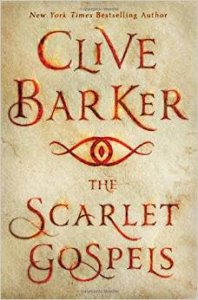Paul Di Filippo reviews Clive Barker
The Scarlet Gospels, Clive Barker (St. Martin’s 978-1-250-05580-4, $26.99, 368pp, hardcover) May 2015
 It’s now thirty years on from the moment when Clive Barker burst into the consciousness of readers with his Books of Blood, story collections that signaled a new style of horror fiction for the latter portion of a twentieth century that had outpaced the older, staider modes of literary creepiness. That impressive launch has been matched, although arguably not surpassed, by his subsequent work, which has maintained a high standard of splattery shivers. Barker’s newest novel extends and caps his Hellraiser franchise with suitably gory glory.
It’s now thirty years on from the moment when Clive Barker burst into the consciousness of readers with his Books of Blood, story collections that signaled a new style of horror fiction for the latter portion of a twentieth century that had outpaced the older, staider modes of literary creepiness. That impressive launch has been matched, although arguably not surpassed, by his subsequent work, which has maintained a high standard of splattery shivers. Barker’s newest novel extends and caps his Hellraiser franchise with suitably gory glory.
This specific demonic universe of Barker’s began in 1986 with The Hellbound Heart, which quickly morphed from page to screen as Hellraiser. Readers and viewers were introduced to the Cenobites, an infernal order of malign and merciless beings, chief among whom was the now iconic Pinhead (a name which the creature detests, by the way, and wouldn’t you?). With eight films total, as well as some graphic novels, Pinhead’s story and mythology became highly ramified, and, not being utterly conversant with everything, I am no authority on the minutiae of Mr. Nail Brain’s continuity.
Now switch to another Barker protagonist, occult detective Harry D’Amour. He had cameos in some early work by Barker, but made his significant debut in the novel Everville, in 1994. Like Pinhead, D’Amour next jumped to film with Lord of Illusions in 1995.
Now, in The Scarlet Gospels, Pinhead and D’Amour go mano-a-mano, and of course only one of them can emerge victorious.
The book opens with Pinhead appearing vengefully before the last six master mages of Earth and slaughtering all but one of them in Grand Guignol style. (That survivor, Felixson, will go on to suffer a fate certainly worse than mere annihilation.) Now, this highly graphical foretaste of the carnal and psychical horrors to come will surely challenge readers who don’t normally go in for this type of fiction, and in fact such over-the-top carnage raises the tangential issues of torture porn, boundaries of good taste, etc. But although I myself often fall into that sector of readers who generally prefer my horror fiction to be more abstract and “refined,” I found myself sticking with the narrative, and gratified at the end of the book that I had persisted. Why? The answer, I think, relates to four qualities of Barker’s writing.
First, one has to respect Barker’s uncensored self-expression. His unfettered imagination is king. Basically, he is intent on taking all those somewhat glib Lovecraftian sentences such as “The demon had its way with the poor mortal” and unpacking them to show us what is really involved in such a throwaway line, making us reconsider our addiction to easy violence.
Second, is the quality of the writing. I am willing to forgive a lot when the prose is purty, and Barker can indeed craft a sweet sentence. “They looked like shadows thrown up on steam, their edges evaporating, their features scrawled on the air like an artist was working on the rain.” (Although the elitist in me does want to revise that to read “as if an artist were working on the rain.”)
Third is the fact that Barker is primarily a visual thinker. He sees and writes cinematically. His plot here (see below) is not particularly deep or complex or even original. His characters are believable but stock. What really matters to Barker are the visuals, and he is going to depict his eye candy and make you taste it through whatever tools are at his disposal, blunt or sharp. If you don’t want such visuals, you don’t want Barker at all, and might as well go read someone else.
Lastly, there’s the humor. Barker is not precisely serious about all of this. I defy you to read a line like the next quote and then deny that Barker’s tongue is considerably into his cheek. “Caz looked down at Dale and smiled coyly as he brushed a severed nipple off his shoulder.” (That’s a demon nipple, by the way, in case you were wondering.)
In any case, assuming you make it past Pinhead’s initial rampage, what do you encounter?
We next get familiar with occult detective Harry D’Amour and his posse. D’Amour is the latest in a long line of such supernatural-centric sleuths who can be seen most recently in places like DC Comic’s Constantine and Paul Cornell’s two most recent books. It’s a sturdy motif, and D’Amour fills the role nicely. When his pal Norma is abducted by Pinhead, D’Amour has no hesitation about following her to this infernal realm, with the assistance of his pals Caz, Lana and Dana.
We alternate between Harry’s POV and Pinhead’s, and while the human perspective contains much of interest and suspense, what’s really surprising is that Pinhead becomes something of a vaguely sympathetic antihero. It eventuates that our Cenobite Hell Priest in seeking to usurp Lucifer’s place, and their Miltonic battle shakes the very roots of the realm of the damned, with our human “Harrowers” scuttling about to survive, like shrews in the midst of battling dinosaurs.
It’s war in this venue that allows those extravagant visuals I mentioned. In Chapter 21 of Book Two, we get a long, vivid word-portrait of a giant aquatic Hell beast known as the Quo’oto. You think Barker has done all he can with the animal in that passage. Then, a hundred pages later, the Quo’oto literally resurfaces for a titanic climax with Lucifer. It’s Barker pulling out all the stops, ramping up the stakes and trying to outdo himself.
The fate of the human characters is unexpected and affecting as well. A nice touch is how Pinhead and D’Amour become complicit in each other’s schemes in a way. If you stare too long into the abyss, we know, the abyss will stare back.
With the painterly brio of H. R. Giger and Guillermo del Toro, and the transgressive flavor of some French antinovelist, Clive Barker splashes as much crimson on his gospels as the page will permit.





